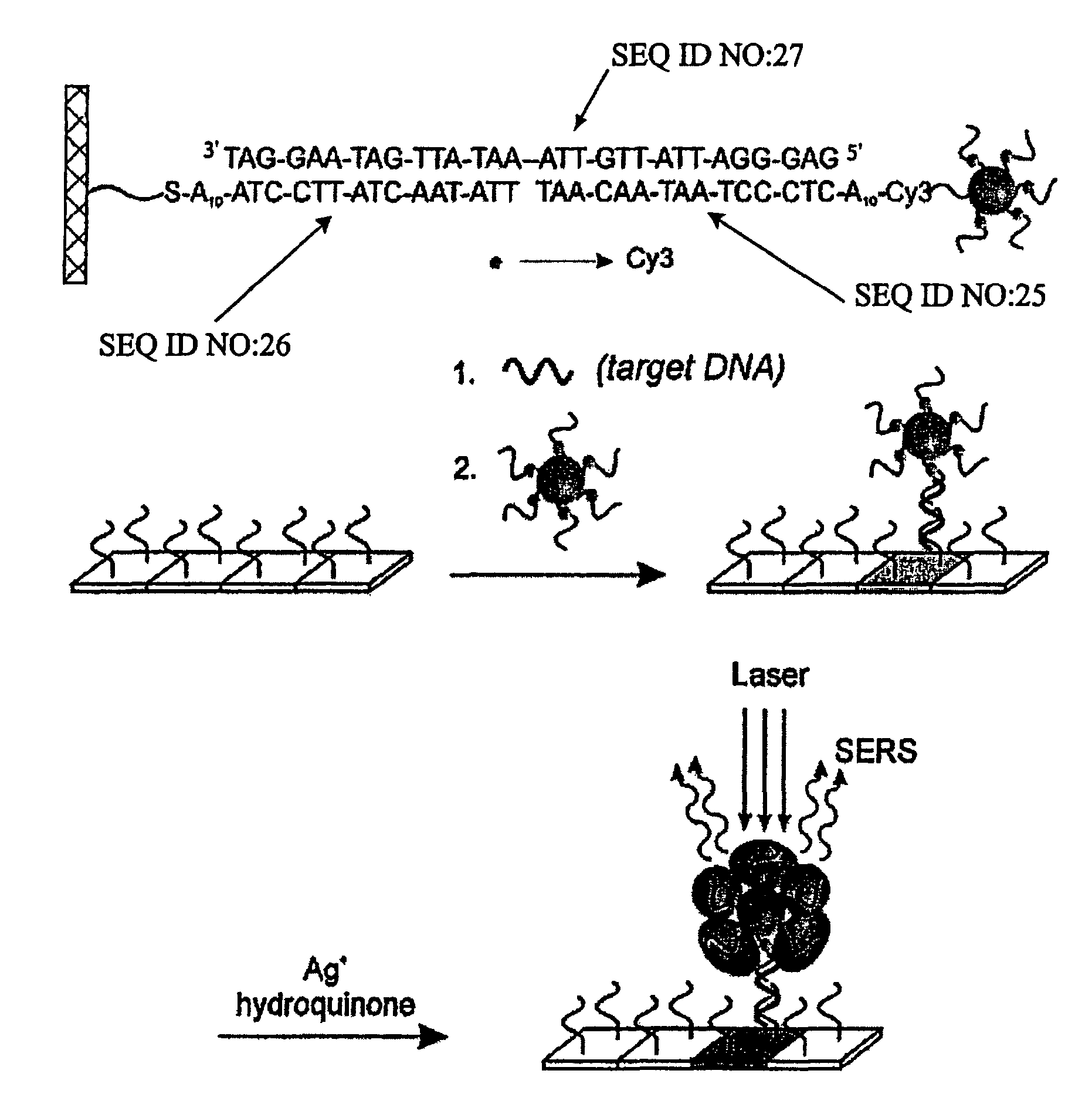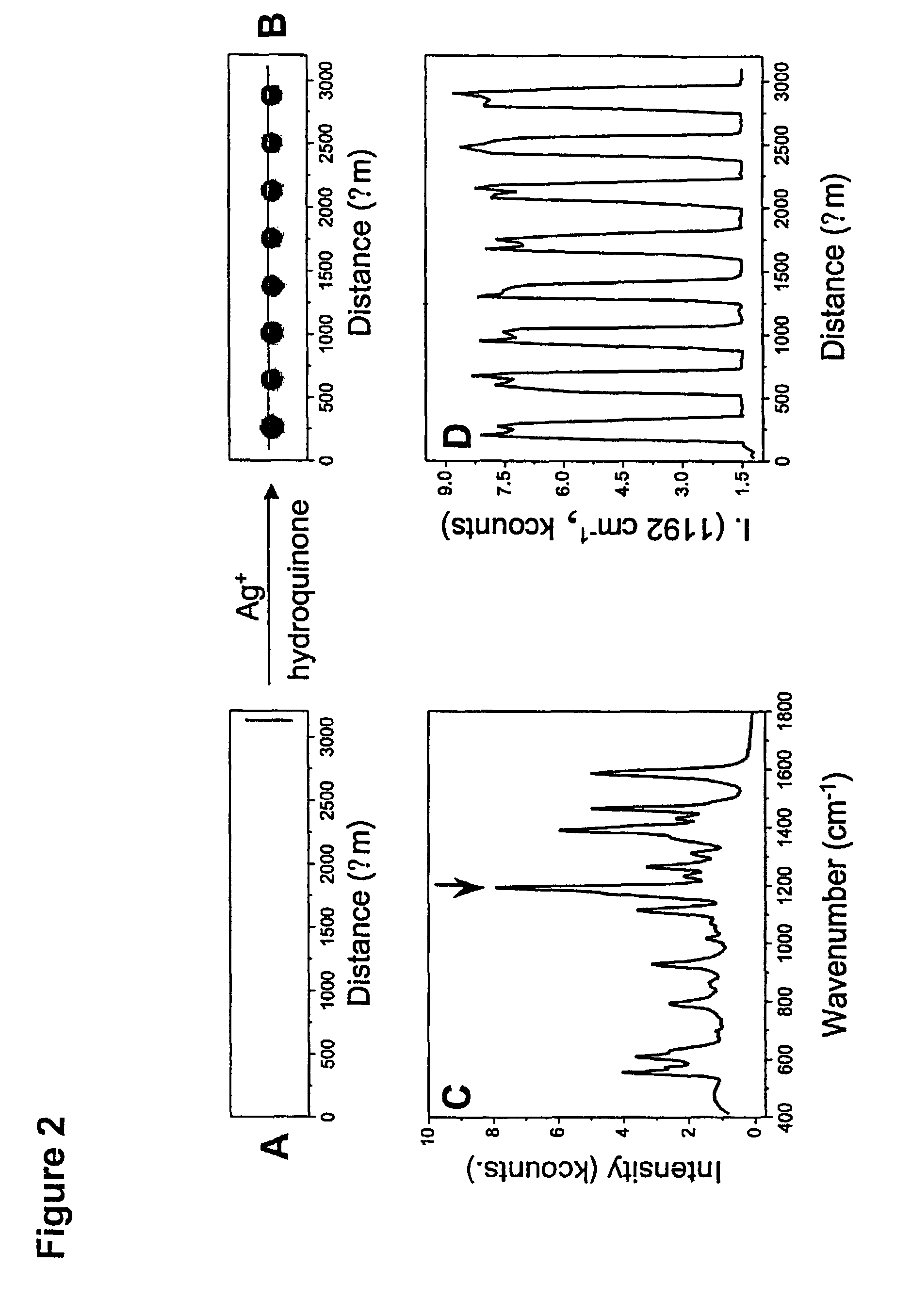Nanoparticle probes with raman spectroscopic fingerprints for analyte detection
a technology of raman spectroscopic fingerprints and nanoparticle probes, which is applied in the field of nanoparticle probes with raman spectroscopic fingerprints for analyte detection, can solve the problems of conspicuous technological absence and difficult to distinguish spectra
- Summary
- Abstract
- Description
- Claims
- Application Information
AI Technical Summary
Benefits of technology
Problems solved by technology
Method used
Image
Examples
example 1
Microarray Fabrication
[0149]Oligonucleotide capture strands were immobilized onto SMPB (succinimidyl-4-(maleimidophenyl)-butyrate) functionalized glass slides by spotting 5′-hexyl-thiol-capped oligonucleotides (1 mM in a 0.15 M NaCl, pH 6.5 phosphate buffer solution (PBS, 10 mM phosphate)) with a commercial arrayer (GMS 417 arrayer, Genotic MicroSystems, Inc). After spotting the chip with the capture oligonucleotides (˜200 μm spots), the chip was kept in a humidity chamber for 12 hours to effect the coupling reaction between SMPB and the hexylthiol-capped oligonucleotides. Then the chip was washed copiously with Nanopure water. Passivation of the areas of the chip surrounding the oligonucleotide spots was carried out by immersing the chip in a solution of hexylthiol-capped poly-adenine (A15) (0.1 mM) for 4 h and then in a solution of 3-mercapto-propane sulfonic acid, sodium salt (0.2 M) for 30 minutes to cap off the remaining SMPB sites. Finally, the chip was washed with Nanopure wa...
example 2
Synthesis and Purification of Cy3-Labeled-(propylthiol)-Capped Oligonucleotides
[0150]The Cy3-modified, (propylthiol)-capped oligonucleotides were synthesized on a 1 mmol scale using standard phosphoramidite chemistry5 with a Thiol-Modifier C3 S—S CPG (controlled-pore glass) solid support on a commercial synthesizer (Expedite). The Cy3-CE phosphoramidite (Indodicarbocyanine 3, 1′-O-(4-monomethoxytrityl)-1-O-(2-cyanoethyl)-(N,N-diisopropyl)-phosphoramidite (Glen Research) was used to incorporate the Cy3 unit in the oligonucleotides. To aid purification, the final dimethoxytrityl (DMT) protecting group was not removed. After synthesis, the CPG-supported oligonucleotides were placed in 1 mL of concentrated ammonium hydroxide for 8 h at 55° C. to cleave the oligonucleotide from the solid support and remove the protecting groups from the bases. In each case, cleavage from the solid support via the succinyl ester linkage produced a mixed disulfide composed of the (mercaptopropyl) oligonucl...
example 3
Synthesis and Purification of TMR-, Cy3.5- and Cy5-labeled-(propylthiol)-capped Oligonucleotides
[0151]This Example describes the syntheses of three oligonucleotides having Raman labels bound thereto: 3′ HS—TMR-A10-AAC CGA AAG TCA ATA [SEQ ID NO. 2 in FIG. 19a]; 3′ HS—Cy3.5-A10-CCT CAT TTA CAA CCT [SEQ ID NO. 3 in FIG. 19a]; and 3′HS—Cy5-A10-CTC CCT AAT AAC AAT [SEQ ID NO. 4 in 19b]. Because the dyes are sensitive to the standard cleavage reagent (ammonia), ultramild base monomers (from Glen Research) were used here to allow the deprotection reaction under ultramild conditions: phenoxyacetyl (Pac) protected dA, 4-isopropyl-phenoxyacetyl (iPr-Pac) protected dG, and acetyl (Ac) protected dC. TAMRA-dT (TMR-dT, 5′-Dimethoxytrityloxy-5-[N-((tetramethylrhodaminyl)-aminohexyl)-3-acrylimido]-2′-deoxyUridine-3′-[2-cyanoethyl)-(N,N-diisopropyl)]-phosphoramidite), Cy3.5-CE phosphoramidite (Indodicarbocyanine 3.5, 1′-O-(4-monomethoxytrityl)-1-O-(2-cyanoethyl)-(N,N-diisopropyl)-phosphoramidite), ...
PUM
| Property | Measurement | Unit |
|---|---|---|
| Diameter | aaaaa | aaaaa |
| Spectrum | aaaaa | aaaaa |
Abstract
Description
Claims
Application Information
 Login to View More
Login to View More - R&D
- Intellectual Property
- Life Sciences
- Materials
- Tech Scout
- Unparalleled Data Quality
- Higher Quality Content
- 60% Fewer Hallucinations
Browse by: Latest US Patents, China's latest patents, Technical Efficacy Thesaurus, Application Domain, Technology Topic, Popular Technical Reports.
© 2025 PatSnap. All rights reserved.Legal|Privacy policy|Modern Slavery Act Transparency Statement|Sitemap|About US| Contact US: help@patsnap.com



